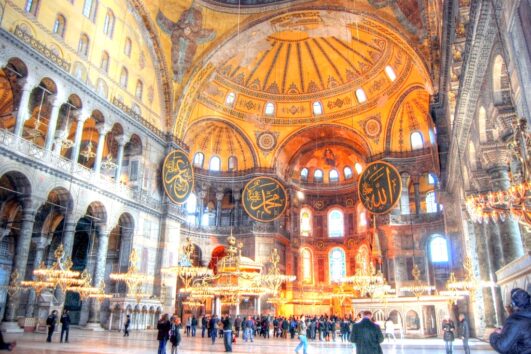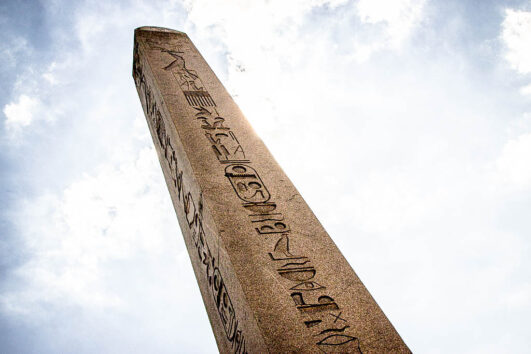As Turkey’s largest city, there is much to do and see in former Constantinople, but the most favorite attractions, especially for first-time visitors sit in the Sultanahmet district of Istanbul. Known as the old part of the city, it was the ruling capital centers for both the Byzantine and Ottoman empires. The iconic landmark structures they left behind receive great admiration from many nationalities.
The area with its “feel good” ambiance has for many years hosted international travelers and tourists so every amenity is on hand to suit all preferences and taste. While the nightlife scene is “low key” compared to others parts of the city, a host of souvenir shops and restaurants serving many world cuisines combine with the attractions to form the perfect 4-day city break. Indeed, in 2014, Istanbul was the sixth most visited city in the world with many of those visitors descending on the Sultanahmet district. So how should you spend your time?
Sightseeing in the Sultanahmet District of Istanbul
The Angelic Hagia Sophia
The former church, mosque, and now museum of the Hagia Sophia is a magnificent building wowing everyone who walks through her doors. Once known as the largest domed landmark in the world, it is probably the large Islamic calligraphy plaques adorning the upper levels of the interior walls that peaks people’s interest. Yet its beginnings were born into fruition many centuries before in 537AD during Byzantine rule. Although at one stage, the Byzantine interior mosaics were plastered over or removed altogether, years of painstaking work has uncovered most of them. In 2015, the Turkish Ministry of Culture and Tourism said it was the country’s most visited attraction, explaining its holy influence and historical lure.

The Majestic Blue Mosque
Standing across the square from the Hagia Sophia, the Grand Blue Mosque dating from 1616 is also known as the Sultanahmet Cami. Its large size, and six minarets dominating the horizon certainly impact everyone who sees it for the first time, yet its claim to fame is the 20,000 handmade interior Iznik tiles and 200 stained glass windows. Even though it is one of the country’s most visited tourist sites, it is still a fully practicing place of worship and visiting hours are conducted around the five daily prayer times. In 2006, the Pope visited the Blue Mosque and spent 2 minutes in private thought and prayer. Barack Obama is another important dignitary to have seen the interior décor and architecture.

Topkapi Palace : Home of the Ottoman Sultans
Sitting around the corner from the beautiful Hagia Sophia, the vast, sprawling Topkapi Palace is an iconic reminder of the early days of the Ottoman Empire from their invasion of Constantinople until their move in the 19th century to the more wes
ternized Dolmabahce Palace. As their home and also command center from which their ruled their empire, the mass network of courtyards and rooms were a fully functioning city holding thousands of people including the sultan’s family, and staff. The palace in itself is an architectural wonder, yet it has two more claims to fame. The fourth largest diamond in the world, the spoon makers jewel is housed here, and the ancient relics room contains items that belonged to the Prophet Muhammad. Including rooms like the circumcision quarters, jewelry, armory, and kitchens, another must visit section is the harem which holds untold secrets behind its closed doors.

The Underground Basilica Cistern
Famously featured in James Bond’s film called “From Russia with Love” the underground Basilica Cistern was a water source for Constantinople. Another of its most famous visitors, Mark Twain, calle
d it, the thousand one and column and he was delighted with the long archways and masses of columns disappearing into the darkness. These days, the fish swimming in among the columns receive the most attention alongside the upside-down head of Medusa at the back of the cistern. No-one is entirely sure why it was placed like that, and we can only surmise that it was to represent the myth that she turned people to stone.

The Hippodrome
The Hippodrome of Constantinople was the social scene for the glory days of the Byzantine Empire. Horse and chariot racing took place in the massive u shaped landmark structure that measured 450 meters and held up to 100,000 roaring spectators. It was also the scene of the famous Nika riots in 532 AD in which more than 30,000 people died. These days, little is left of its former glory apart from the serpent column, walled obelisk and the 3,500-year-old obelisk of Thutmose that was sourced in from Egypt.

The Turkish and Islamic Arts Museum
A small and unobtrusive building holds The Turkish and Islamic Arts Museum that not only serves up a great cup of Turkish coffee but also contains many antique Turkish carpets and artifacts. The building was a former home to a grand vizier of the Ottoman Sultan Suleyman the magnificent, but these days ethnographic displays sit within the rooms portraying an accurate lifestyle for the old nomad groups of Turkey.
The Istanbul Archaeological Museum
Holding artifacts from many of the former Ottoman empires territory, the Istanbul Archaeological Museum is the Turkish equivalent of the great British Museum. History lovers could easily spend a day exploring the exhibitions and displays holding some of the world’s most priceless artifacts. Including the Alexander sarcophagus from Lebanon, the tiled lions from Baghdad and cargo remains of numerous ships that sank between the 5th and 11th centuries, Istanbul Archeology Museum is by far the best museum in Turkey.

Shop in the Grand Bazaar
The above are the main sites to see in the Sultanahmet district of Istanbul, but most first time visitors end their stay by visiting one of the largest marketplaces in the world, the Grand Bazaar. Sitting in the nearby district of Fatih, more than 4000 shops cover 60 narrow streets forming a vast network mass that is the shopping mecca of Turkey. Built shortly after the invasion of Constantinople, for hundreds of years it was a major stopping point for traders on the old silk road yet these days is mostly visited by foreigners for its iconic history and also to shop for souvenirs.

You May be Interested in…
Our private tour of the Sultanahmet district of Istanbul visits many of the landmarks above. Tailor the experience to your own preference and receive the intricate knowledge of a licensed and qualified guide specialising in the history of Constantinople and Istanbul. More about that here.
Further Reading….
Browse through our full list of Istanbul tours: Exploring the new part of the city as well as themes such as Jewish heritage, our private and guided tours remove all the hassle of transport, tickets, and navigating your way around, leaving you to enjoy the experience.
Read more from our Turkey Travel Blog: If you are planning to explore more of Istanbul and the country of Turkey, our blog talks about places to go, souvenirs, culture, traditions and much more.






